Gray Wolves
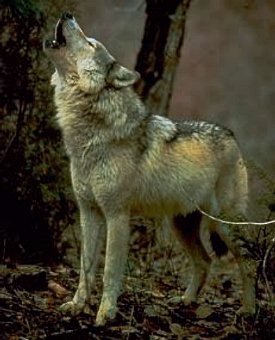
Gray wolves, also known as Canis Lupus. In the U.S. there are an estimated 6,000
to 8,000 wolves in Alaska and 2,700 in the lower 48 states. Gray wolves live up to eight
years, and on average a gray wolf stands 26 to 32 inches at the shoulder and they weigh 55
to 115 pounds. Today wolves are reduced to certain parts of the United State. Alaska, Idaho,
Michigan, Minnesota, Montana, Wisconsin, and Wyoming. Other places where wolves live are,
Canada, Europe, Asia, the Middle East and Russia.
All gray wolf populations in the lower
48 states are listed as endangered except in Minnesota, where they are listed as threatened.
Populations in Alaska are unlisted. Gray Wolves normally prey on large hoofed mammals
such as deer and elk but occasionally they will prey on smaller animals such as beavers
or rabbits.
The gray wolf also called the Timber Wolf, is the largest of about 41 wild species within
the dog family, Canidae, of the order Carnivora. Their coats may vary in color from gray
to brown, from white to jet black.
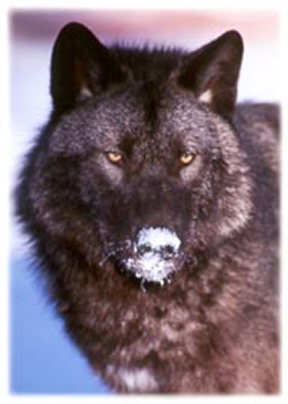
Gray Wolves usually hunt at night and feed on the larger hoofed animals. But sometimes
they will eat berries, birds, beaver, fish, and insects. Animals that they gray wolves kill
are usually young, old, or otherwise weaker members of their populations because they are
the easiest to capture. Most of the time the gray wolf will only pursue its prey from about
110 yards to 3.1 miles. A fact known by those who love wolves, is that healthy wolves
will rarely, if ever, attack humans.
The Gray wolf mates for life and lives in a packs which can vary in size, from 2 to over 15, but are usually from 4 to 7 wolves. The leader is normally the strongest wolf, who often determines when and where the pack will hunt, as well as other activities of the pack. The gray wolves territories may cover from 100 to 260 sq. miles, depending on the abundance of food and water. Territories may also overlap, although wolf packs very seldom confront eachother. Some wolves leave their packs to become lone wolves. Loners may start thier own packs if a mate and a vacant area can be found.
The Gray wolves breeding season can vary from January in low latitudes to April in high latitudes. The Gray Wolves alternate between a stationary phase in the spring and summer time. And a nomadic phase in the autumn and winter. The stationary phase includes caring for pups at a den or at a homesite. During the summer, most movements are towards or away for the pups, and adults often travel and hunt alone. When autumn comes around pups are capable of traveling extensively with the adults, so until the next whelping season the pack usually roams as a unit throughout its territory is search of prey. Usually the highest ranking male and female in a pack will breed, all members of the pack are involved in raising the young. The most common things that wolves die from are: persecution by humans, killed by other wolves, diseases, parasites, starvation, and injuries for prey. Most wolves probably live less than 10 years in the wild.
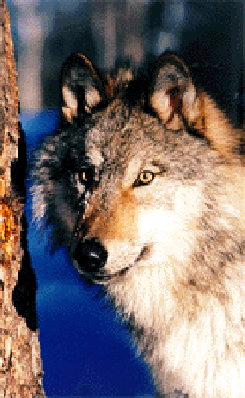
Gray wolves like maned and red wolves, mate for life. Usually only the alpha pair will breed. Pairs mate in the winter and about 9 weeks later 2 to 14 pups are born. Pups are born blind so they rely on their parents to help them. Other females in the pack help take care of newborn pups. Within 3 to 5 months the young pups are able to travel with the pack.
The Gray Wolves inhabit Michigan's Upper Peninsula, northern Minnesota and Wisconsin and a large geographic range in Alaska, Canada, Europe, Middle East and Asia. THe gray wolf once lived in diverse regions as Israel and Egypt. Most of the gray wolves chose to live in the forest areas of Northern Michigan, Minnesota and Wisconsin. Another approximate number of gray wolves are: 2,500 gray wolves in the lower 48 states and about 10,000 in Alaska.
Earlier this century people worldwide believed wolves should be hunted and killed because wolves were killing cattle and deer. Wolf populations were the lowest in Eurasia between the 1930's and 1960's. In the 1950's wolf numbers were the lowest in North America.
Just recently, 30 gray wolves were re-introduced to Yellowstone National Park in Wyoming. A thriving wolf population lives in northern Minnesota and there is an isolated population on Isle Royale National Park, Michigan. Worldwide, gray wolves are coming back due to research and public education efforts. Gray wolves now live in Rome (Italy), Spain, France, Poland, Germany, the former Soviet Union, Finland, Norway, and Sweden.
The Language of Gray Wolves. Gray wolves communicate to each other through howling, body language and scent. Howling is used to assemble the pack, talk to other packs, assert territorial claims or as a source of pleasure. On a calm night, howls can be heard from as far as 120 miles away. Wolves use their faces and tails to indicate their emotion and status in the pack. A pack marks its territory by urine and feces.
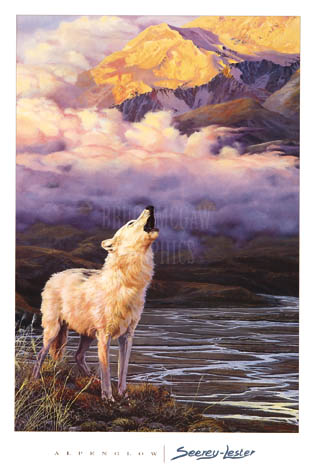 The Gray Wolves easy info: From the Kingdom of Animals and the class of mammals. The order of Carnivores and the species of Lupus (gray wolf). The average height of gray wolves is 2-3 feet at shoulders and the average length 4 1/2 to 6 1/2 feet long, tip of nose to tip of tail. They weigh 50 up to 150 pounds. And their paw size is 3 1/2 x 4 1/2. Some of this information you may have encountered earlier in this site of earlier on this page but each wolf has a different size and these sizes are the average. The gray wolf is the largest of the dog family.
The Gray Wolves easy info: From the Kingdom of Animals and the class of mammals. The order of Carnivores and the species of Lupus (gray wolf). The average height of gray wolves is 2-3 feet at shoulders and the average length 4 1/2 to 6 1/2 feet long, tip of nose to tip of tail. They weigh 50 up to 150 pounds. And their paw size is 3 1/2 x 4 1/2. Some of this information you may have encountered earlier in this site of earlier on this page but each wolf has a different size and these sizes are the average. The gray wolf is the largest of the dog family.
Wolves have two fur coats: *The undercoat- This coat is thick like wool and traps air to help keep the wolf warm.
*The Overcoat(guard hairs)- These hairs are coarseand hollow. This gives another layer of insulation against the cold. The gray wolves have gray fur, black fur, and sometimes they can have white fur. (Here is some colors that gray wolves can be: white, gray, black, brown, red, and yellow.) Usually gray wolves are a combination of colors. The eye color of gray wolves is golden to yellow eyes. Some wolves have brown eyes and very rarely they have green eyes. But puppies are always born with blue eyes.
*Leg length- Long legs and very large heads. Their necks are quite small for as big as they are.
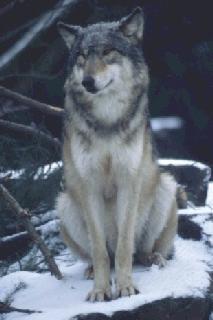
*Shoulders- They have narrow shoulders and a narrow rear end. This lets them accelerate fast. Useful when trying to catch a bite to eat.
Wolf Talk-
*Howling
*Barking
*Growling
*Whining
*Yipping
Gray wolves will breed anytime between January and March. It all depends on where they live. The further north, the later in the season they breed. It takes 63 days after breeding to have puppies. This is the same as the dog. It should be, since dogs came from wolves.
The Gray wolves diet consists of: deer, caribou, musk oxen, beaver, dall sheep, mountian goat, fish, birds, carrion, elk, bison, moose, big horn sheep, and small animals.
